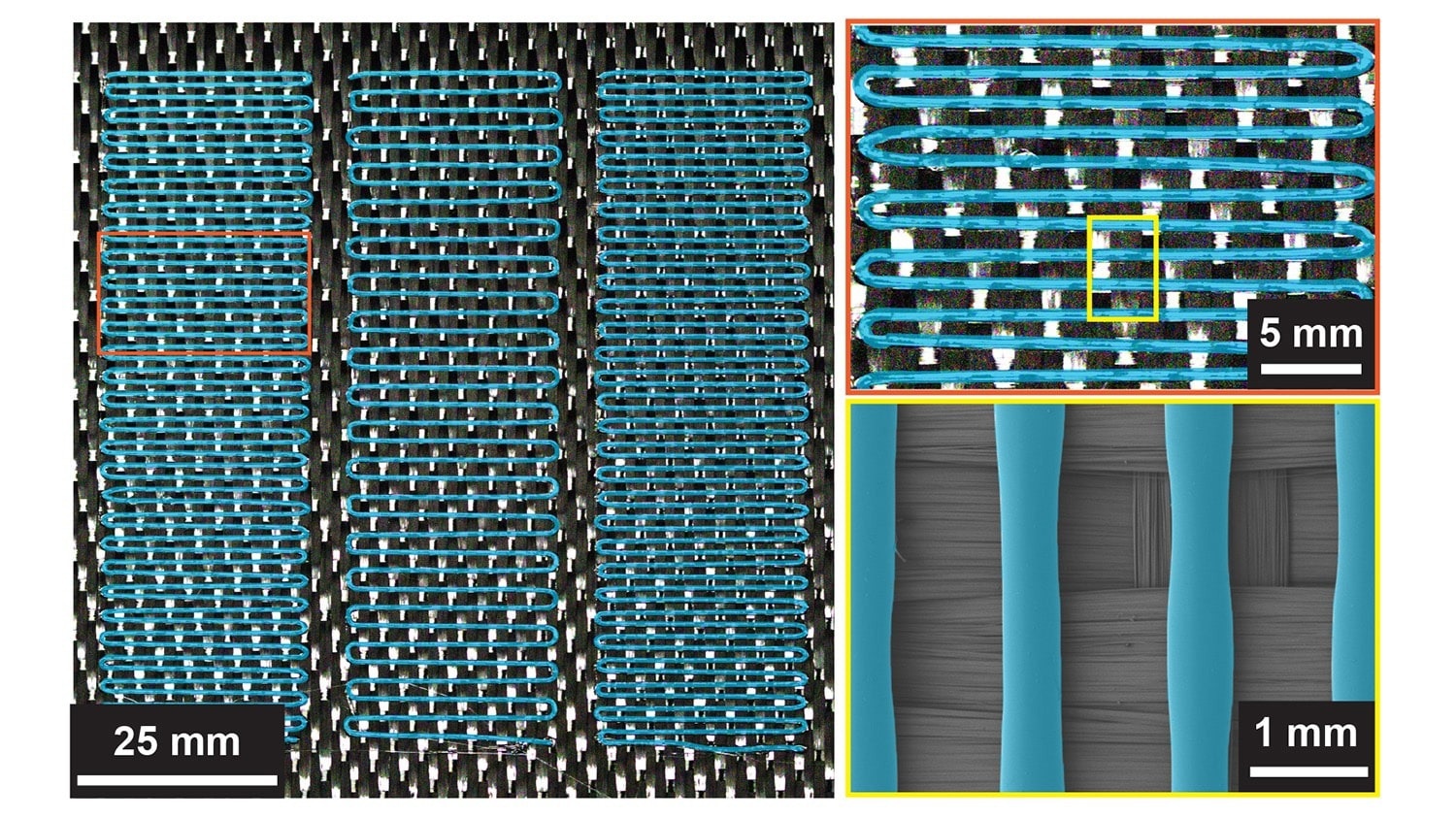Reviewed by Emily Henderson, B.Sc.Nov 1 2022
Engineering researchers developed a new self-healing composite, enabling structures to repair themselves in place, without having to be eliminated from service.
 3D printed thermoplastic on woven-carbon fiber reinforcement. Image Credit: NC State University
3D printed thermoplastic on woven-carbon fiber reinforcement. Image Credit: NC State University
This new technology settles two long-term difficulties for self-healing materials and can also considerably extend the lifespan of structural components like aircraft wings and wind-turbine blades.
Researchers have developed a variety of self-healing materials, but previous strategies for self-healing composites have faced two practical challenges.
Jason Patrick, Study Corresponding Author and Assistant Professor, Civil, Construction, and Environmental Engineering, North Carolina State University
Patrick continued, “First, the materials often need to be removed from service to heal. For instance, some require heating in an oven, which can’t be done for large components or while a given part is in use. Second, the self-healing only works for a limited period.”
“For example, the material might be able to heal a few times, after which its self-repairing properties would significantly diminish. We’ve come up with an approach that addresses both of those challenges in a meaningful way while retaining the strength and other performance characteristics of structural fiber-composites,” added Patrick.
Taking things on a practical note, this implies that users could depend on a provided structural component, like a wind-turbine blade, for a much longer period without having any concerns regarding failure.
By increasing the longevity of these composites, we make them more sustainable. And while wind-turbine blades are a good example, structural composites are found in a wide variety of applications: aircraft wings, satellites, automotive components, sporting goods, you name it.
Jason Patrick, Study Corresponding Author and Assistant Professor, Civil, Construction, and Environmental Engineering, North Carolina State University
The study elaborates on the working of new and self-healing fiber-reinforced composite.
Laminated composites are composed of layers of fibrous reinforcement, for example, glass and carbon fiber, joined collectively. Most often, damage occurs when the so-called “glue” that binds such layers together starts to peel away from the reinforcement or exfoliate.
The research group fulfilled this issue by 3D printing a pattern of the thermoplastic healing agent onto the reinforcement material. Also, the scientists inserted thin “heater” layers in the composite.
On applying an electrical current, the heater layers tend to warm up. This, in return, thaws the healing agent, flowing into any cracks or microfractures inside the composite and then repairs them.
We’ve found that this process can be repeated at least 100 times while maintaining the effectiveness of the self-healing. We don’t know what the upper limit is, if there is one.
Jason Patrick, Study Corresponding Author and Assistant Professor, Civil, Construction, and Environmental Engineering, North Carolina State University
Furthermore, the printed thermoplastic improves inherent resistance to fracture by up to 500%. This implies that it needs more energy to produce delamination initially. Besides, the heater layers and healing agent are all made of readily available materials and are comparatively affordable.
Patrick stated, “While making composites that incorporate our design would be marginally more expensive, the cost would be more than offset by significantly extending the lifespan of the material,” Patrick says.
The new technology holds another advantage; if integrated into aircraft wings, the internal heating elements would enable airlines to halt using chemical agents to eliminate ice from wings when aircraft are left on the ground and also to de-ice in flight.
Patrick added, “We’ve demonstrated that this multi-functional technology works. We’re now looking for government and industry partners to help us tailor these polymer-based composites for use in specific applications.”
The study's first author is Alexander Snyder, a Ph.D. student at NC State. The study was co-authored by Zachary Phillips and Jack Turicek, Ph.D. students at NC State; Charles Diesendruck of Technion–Israel Institute of Technology; and Kalyana Nakshatrala of the University of Houston.
The work was done with the financial support offered by the U.S. Air Force Office of Scientific Research, under grant number FA9550-18-1-0048, and the Department of Defense’s Strategic Environmental Research and Development Program, under grant number W912HQ21C0044.
Journal Reference:
Snyder, A. D., et al. (2022) Prolonged in situ self-healing in structural composites via thermo-reversible entanglement. Nature Communications. doi.org/10.1038/s41467-022-33936-z.